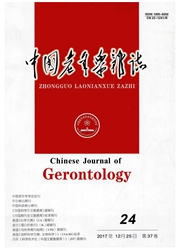

 中文摘要:
中文摘要:
目的基于熵变理论与证素辨证系统探讨绝经后骨质疏松肾阳虚证的中医病理特点。方法选择90例绝经后骨质疏松肾阳虚证患者为观察对象,绝经后女性且无骨质疏松症30例对照组,采用证素辨证积分方法进行临床观察,双能X线骨密度仪检测股骨近端的骨密度变化。结果绝经后骨质疏松肾阳虚证患者的病性由重到轻依次是阳虚、阴虚、血瘀、气滞、湿、痰、寒、气虚、血虚、热;病位由重到轻依次是肾、肝、脾、筋骨、经络;证素积分随着肾阳虚证分级的增加而明显增加(P<0.01);骨密度下降的程度虽随肾阳虚证分级的增加有增加趋势,但无统计学意义(P>0.05);肾阳虚证的证素积分可以较好反映体内的熵变情况。结论绝经后骨质疏松肾阳虚证的中医病理特点是以虚为主,存在虚实夹杂、多脏腑病变,其核心病机是肾虚骨痿,为揭示熵变与绝经后骨质疏松肾阳虚证之间的内在联系提供研究基础。
 英文摘要:
英文摘要:
Objective Based on entropy change theory and syndrome element differentiation to explore the traditional Chinese medi -cal pathological character of kidney-yang deficiency pattern of postmenopausal osteoporosis .Methods 90 elderly postmenopausal women vol-unteers with osteoporosis and 30 cases healthy women volunteers were enrolled .Clinical observation was used by the integration method of syndrome element differentiation ,the bone mineral density change of proximal femur was measured by Dual Energy X -Ray Bone Densitome-ter.Results The order of the disease nature from serious level to light level in kidney-yang deficiency pattern of postmenopausal osteoporosis was Yang Deficiency,Yin Deficiency,Blood Stasis,Stagnation of Qi,Hygrosis,Phlegm,Cold,Qi Deficiency and Blood Deficiency;the order of the disease location from serious level to light level was kidney ,liver,spleen,bone and tendon ,and channels and collaterals .The integration of syndrome element differentiation with the increase of Kidney-Yang deficiency grade was significantly enhanced (P<0.01);the decrease degree of bone mineral density with the increase of Kidney-Yang deficiency grade was more to come ,however,there was no significance(P>0.05). Conclusions The traditional Chinese medical pathological character of kidney-yang deficiency pattern of postmenopausal osteoporosis is pre-dominant deficiency,deficiency-excess complication and multiple organs'malfunction,and the pathogenesis interpretation of the cause onset and process of an illness is Kidney Deficiency and Gu Wei .It provides a basic work for revealing the internal relations between entropy change and kidney-yang deficiency pattern of postmenopausal osteoporosis .
 同期刊论文项目
同期刊论文项目
 同项目期刊论文
同项目期刊论文
 Tongue coating microbiome regulates the changes in tongue texture and coating in patients with post-
Tongue coating microbiome regulates the changes in tongue texture and coating in patients with post- 期刊信息
期刊信息
